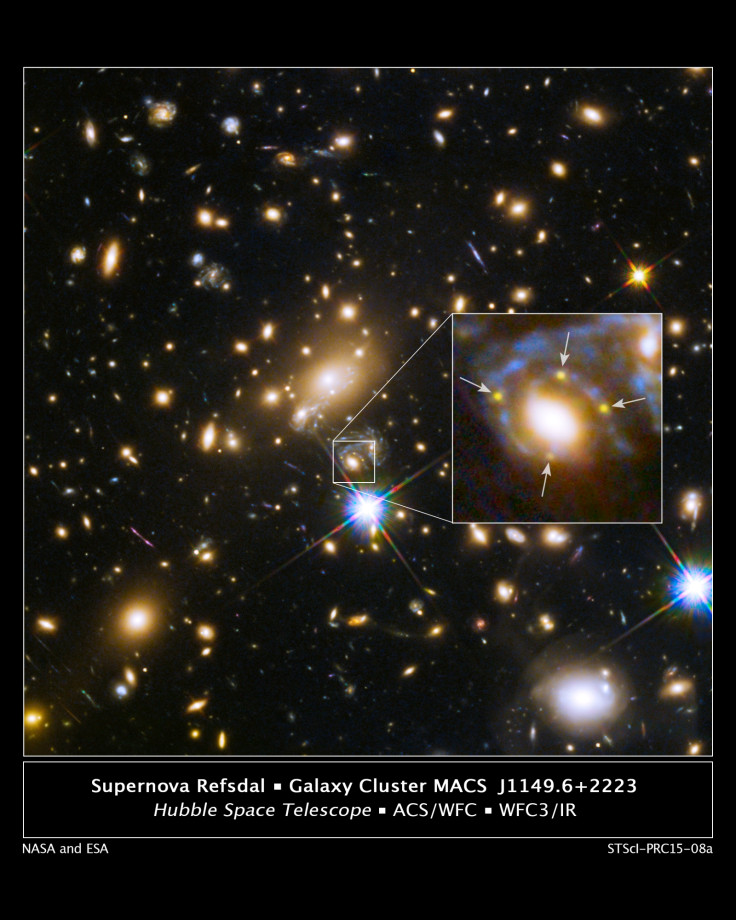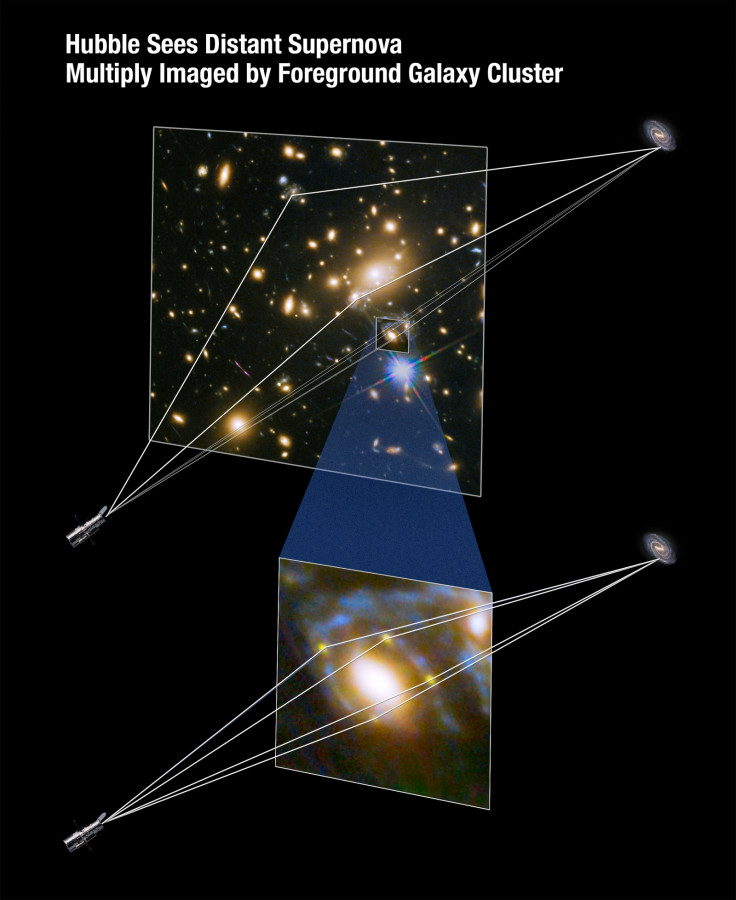Rare cosmic alignment sees dark matter in cluster galaxy split images of supernova

Dark matter in a cluster of galaxies has delivered the first split images of a distant supernova in a demonstration of Einstein's gravitational lensing effect.
The Hubble Space Telescope's multiple images of the exploding star are caused by the warping of space by the powerful gravity of the cluster and one of its constituent red elliptical galaxies.
The supernova appears about 20 times brighter than its natural brightness, due to the combined effects of two overlapping lenses.
The dominant lensing effect is from the massive galaxy cluster, which formed at least three of the images.
A secondary lensing effect occurs when one of those light paths happens to be precisely aligned with a specific elliptical galaxy within the cluster.
First predicted by Albert Einstein, the gravitational lensing effect is similar to a glass lens bending light to magnify and distort the image of an object behind it. The multiple images around the elliptical galaxy formed a cross-shaped pattern called an Einstein Cross, a name originally given to a particular multiply imaged quasar.
The elliptical galaxy and its cluster, MACS J1149.6+2223, are 5 billion light-years from Earth. The supernova behind it is 9.3 billion light-years away.
While multiple images of stellar objects have been seen before produced by the same lensing effect, this is the first time a distant supernova has been caught in a serendipitous cosmic alignment.
"It really threw me for a loop when I spotted the four images surrounding the galaxy — it was a complete surprise," said Patrick Kelly of the University of California, Berkeley, a member of the Grism Lens Amplified Survey from Space (Glass) collaboration.
Dark matter at work
Astronomers hope to use the observations to refine their estimates of the amount and distribution of dark matter in the lensing galaxy and cluster. Dark matter that makes up most of the universe's mass can only be seen in such indirect methods.
Kelly is the lead author of the science paper, published in a special issue of the journal Science celebrating the centenary of Albert Einstein's Theory of General Relativity.
The first gravitational lens was discovered in 1979. Lensing provides a window into the extremely faint universe just after its birth 13.8 billion years ago.
When the path of the light is far from the mass, or if the mass is not especially large, "weak lensing" will occur, and the background object is not much distorted. When the background object is almost exactly behind the mass, however, "strong lensing" can smear huge objects into an "Einstein ring" surrounding the lensing galaxy or cluster.
Strong lensing of small, point-like objects, on the other hand, often produces multiple images - an Einstein cross - arrayed around the lens.
In 2009, astronomers reported that the present cluster created the largest known image of a spiral galaxy by lensing. The present supernova is located in one of that galaxy's spiral arms, which also appears in multiple images around the foreground lensing cluster.
The supernova, however, is split into four images by a red elliptical galaxy within the cluster.
"We get strong lensing by a red galaxy, but that galaxy is part of a cluster of galaxies, which is magnifying it more. So we have a double lensing system," Kelly said.
Based on computer model predictions, astronomers expect to catch a rerun of the supernova within the next five years and suspect it may have appeared in the recent past as a single image elsewhere in the cluster field.
The computer models of the cluster describe the various paths the supernova light takes through the maze of clumpy dark matter in the cluster. Each beam of light takes a different route and arrives at a different time, due, in part, to differences in the length of the pathways the light follows to reach Earth.
The four supernova images captured by Hubble, for example, appeared within a few days or weeks of each other.
A re-run expected soon
The time difference is because some of the light gets delayed by travelling around bends created by the gravity of dense dark matter in the intervening galaxy cluster.
"Our model for the dark matter in the cluster gives us the prediction of when the next image will appear because it tells us how long each train track is, which correlates with time," said Steve Rodney of the Johns Hopkins University in Baltimore, Maryland, leader of the FrontierSN team, comparing the journey of light to that of trains.
Measuring the time delays between images offers clues to the type of warped-space terrain the light from the supernova had to cover and will help the astronomers map out the cluster's mass, especially the landscape of dark matter in the cluster.
Kelly spotted the four images of the exploding star on 11 November, 2014.
The FrontierSN and Glass teams have been searching for such highly magnified explosions since 2013, and this object is their most spectacular discovery.
The two teams spent a week analysing the object's light, confirming it was the signature of a supernova. They used the W M Keck Observatory on Mauna Kea, in Hawaii, to measure the distance to the supernova's host galaxy.
The astronomers nicknamed the supernova Refsdal in honour of Norwegian astronomer Sjur Refsdal, who, in 1964, first proposed using time-delayed images from a lensed supernova to study the expansion of the universe.
"Astronomers have been looking to find one ever since," said Tommaso Treu of the University of California, Los Angeles, the Glass project's principal investigator. "The long wait is over!"
The present supernova is also puzzling as it has not yet peaked in brightness and begun dimming as expected. The spectrum of its light shows a signature different from known types of supernovae. Scientists believe it could be a type of core-collapse supernova.
The other explanation for its unusual behaviour could also be that nine billion years ago, stars followed a slightly different set of rules. With fewer metals in the universe, the stars may have grown bigger and died faster.

© Copyright IBTimes 2025. All rights reserved.





















